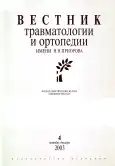The concept of the use of artificial correction of movements in orthopedics, traumatology and prosthetics
- Authors: Vitenzon A.S.1, Petrushanskaya K.A.1
-
Affiliations:
- Federal Scientific and Practical Center for Medical and Social Expertise and Rehabilitation of the Disabled
- Issue: Vol 10, No 4 (2003)
- Pages: 54-58
- Section: Original study articles
- URL: https://journals.rcsi.science/0869-8678/article/view/48172
- DOI: https://doi.org/10.17816/vto200310454-59
- ID: 48172
Cite item
Full Text
Abstract
Principles and methods of artificial movement correction (AMC) with muscle electrostimulation during pathologic gait were considered. It was shown that the most important peculiarity of AMC was phase conformity of artificial and natural irritation as well as construction of muscles at movement. Electrostimulation in M zone, when muscle activity at movement is the maximum one, is obligatory. The main functions of AMC were detected: i.e. therapeutic, diagnostic and prognostic. Indications and contraindications for FMC application as well as technological operation were determined. Clinical and instrumentation evaluation of AMC results in certain pathologic changes of loco-motor system, i.e. crus stump, I—II degree of scoliotic deformity, non-union and pseudoarthrosis of bone crus is given.
Keywords
Full Text
##article.viewOnOriginalSite##About the authors
A. S. Vitenzon
Federal Scientific and Practical Center for Medical and Social Expertise and Rehabilitation of the Disabled
Email: info@eco-vector.com
Russian Federation, Moscow
K. A. Petrushanskaya
Federal Scientific and Practical Center for Medical and Social Expertise and Rehabilitation of the Disabled
Author for correspondence.
Email: info@eco-vector.com
Russian Federation, Moscow
References
- Баев К.В. Нейронные механизмы программирования спинным мозгом ритмических движений. — Киев,1984.
- Витензон А.С. Закономерности нормальной и патологической ходьбы человека. — М.,1998.
- Витензон А.С., Миронов Е.М., Петрушанская К.А., Скоблин А.А. Искусственная коррекция движений при патологической ходьбе. — М.,1999.
- Витензон А.С., Буровой А.М., Петрушанская К.А. и др. Коррекция ходьбы больных с различной патологией опорно-двигательного аппарата посредством многоканальной программируемой электростимуляции мышц: Метод. рекомендации. — М.,2000.
- Витензон А.С., Скоблин А.А., Миронов Е.М., Гаврилов А.В. //Протезирование и протезостроение. — 1996. — Вып. 93. — М., ЦНИИПП. — С. 45-59.
- Шик М.Л. //Физиология движений. — Л.,1976. — С. 234-275.
- Vitenson A.S., Petrushanskaya К.А. //Rus. J. Biomech. — 2002. — Vol. 6, N 2. — P. 33-50.
Supplementary files










